Certificate Templates
These templates define the profile of the certificates that will be issued by the ADSS Local CA (s) and ADSS Key Manager. Default templates exist for various key purposes. New templates can also be defined according to business needs.
The ADSS Server also provides support for the ETSI Qualified Certificates extension. A Qualified Certificate refers to a certificate with a specific qualified status, issued in compliance with the EU Signature Directive and National Signature Laws. These certificates meet rigorous quality standards set by both the Certification Authority and the certificate issuance process. Notably, Qualified Certificates are exclusively issued to individuals, both natural and legal.
The following screen shows the default certificate templates also indicating the purpose of each of these:
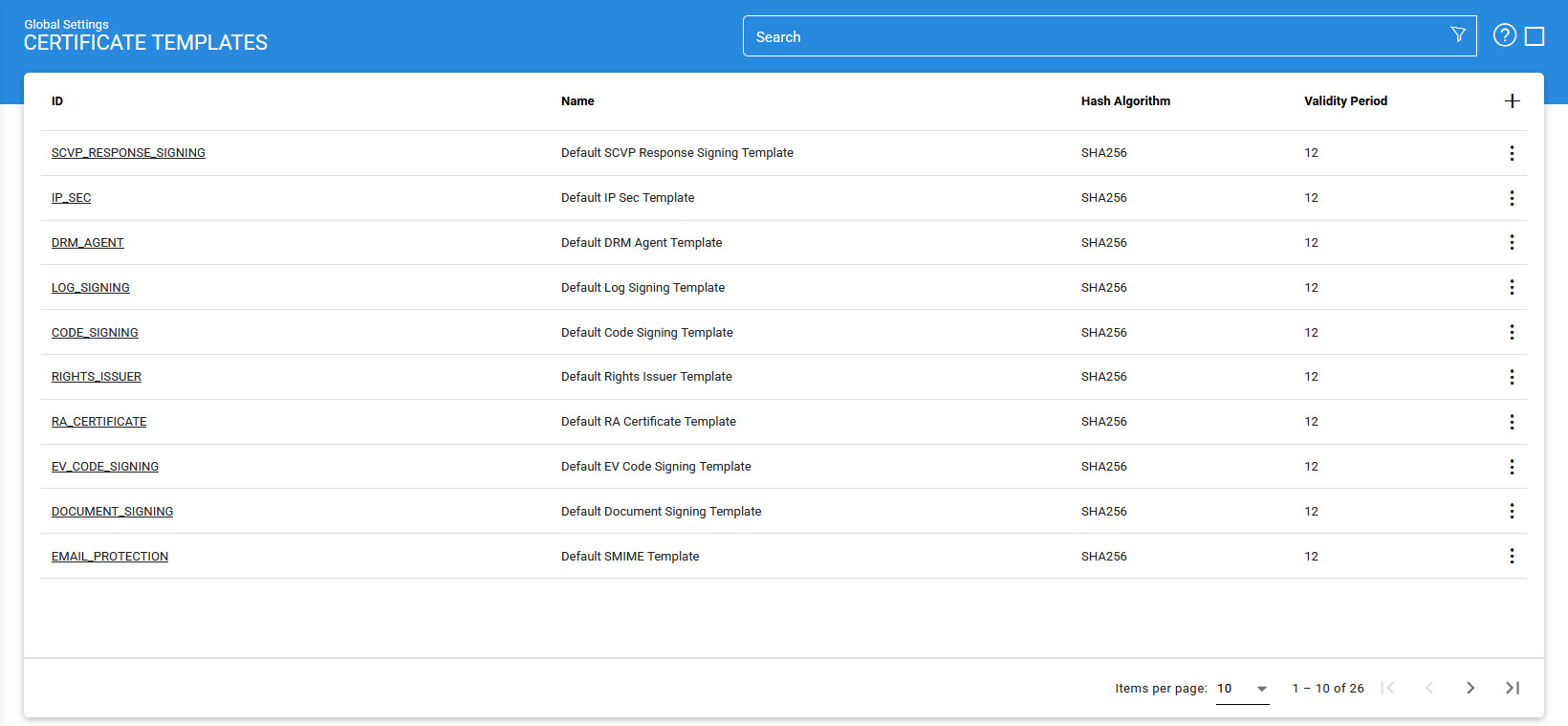
Clicking on the '+' button will lead you to the screen where the required information against the new certificate template can be filled. Following screen will be shown:
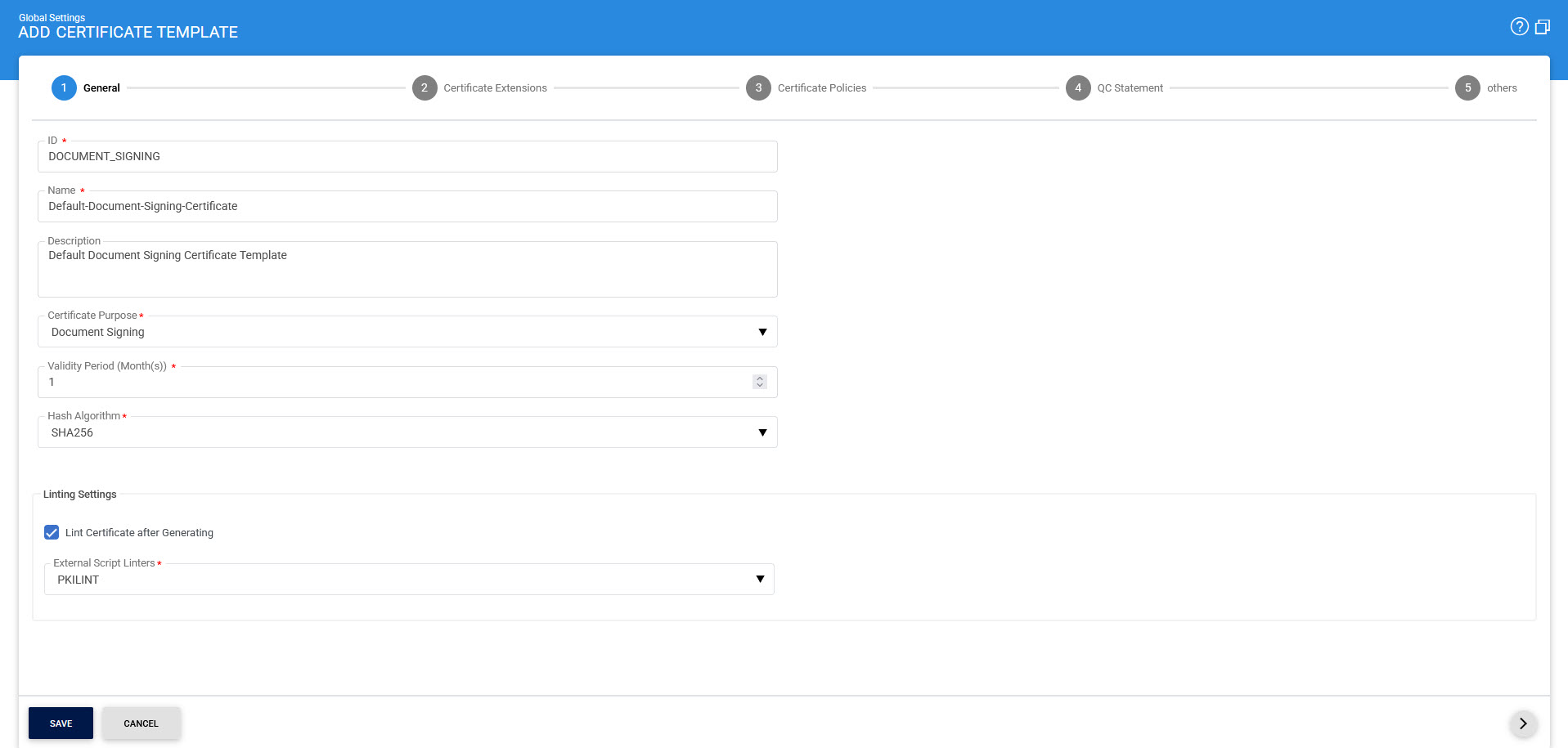
Once the required information on General tab is filled, click on the arrow button (>), it will lead you to Certificate Extensions screen:
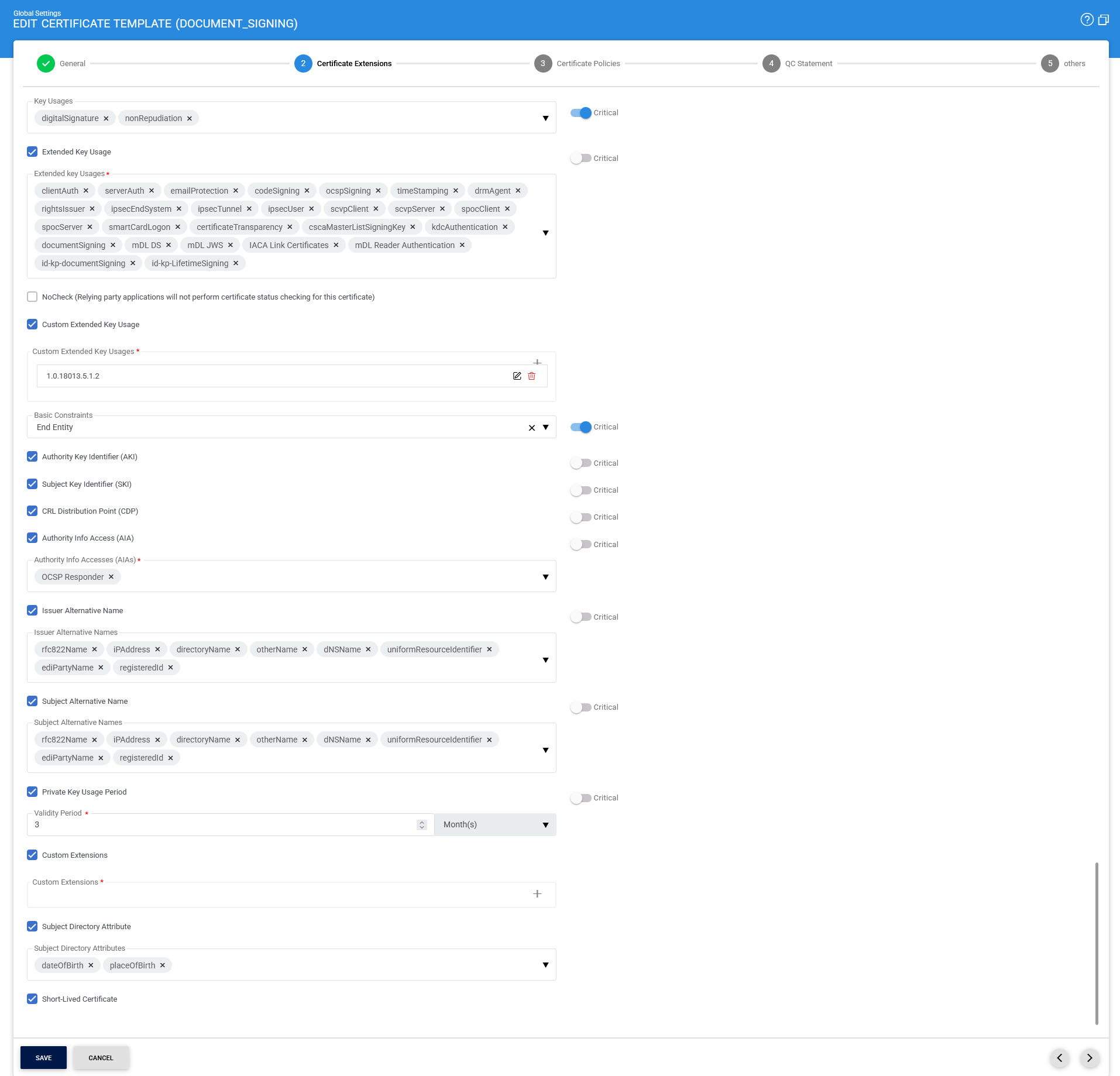
Here the user can attach the certificate extensions required with new certificate template. Once done, click on the arrow button (>), it will lead you to Certificate Policies screen:
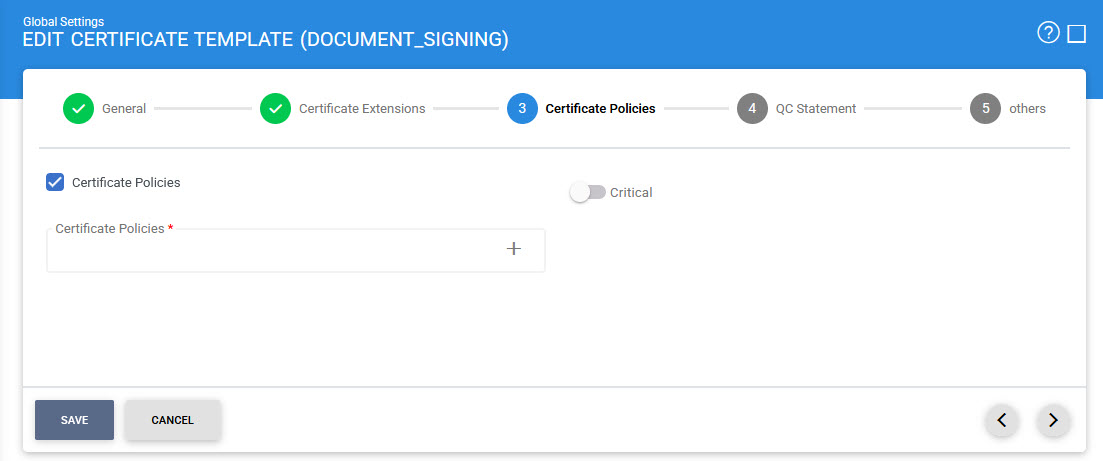
Here the user can define the required certificate policy in the certificate template. In order to define a certificate policy, click on the '+' button, it will open the below screen:
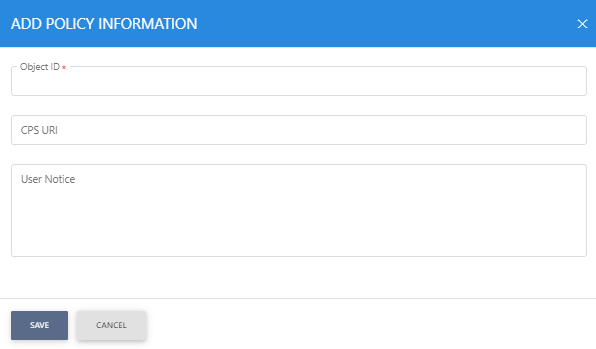
Once the policy is defined by filling the required fields, click on the Save button in order to save the changes. Click on the arrow button (>), it will lead you to QC Statement screen:
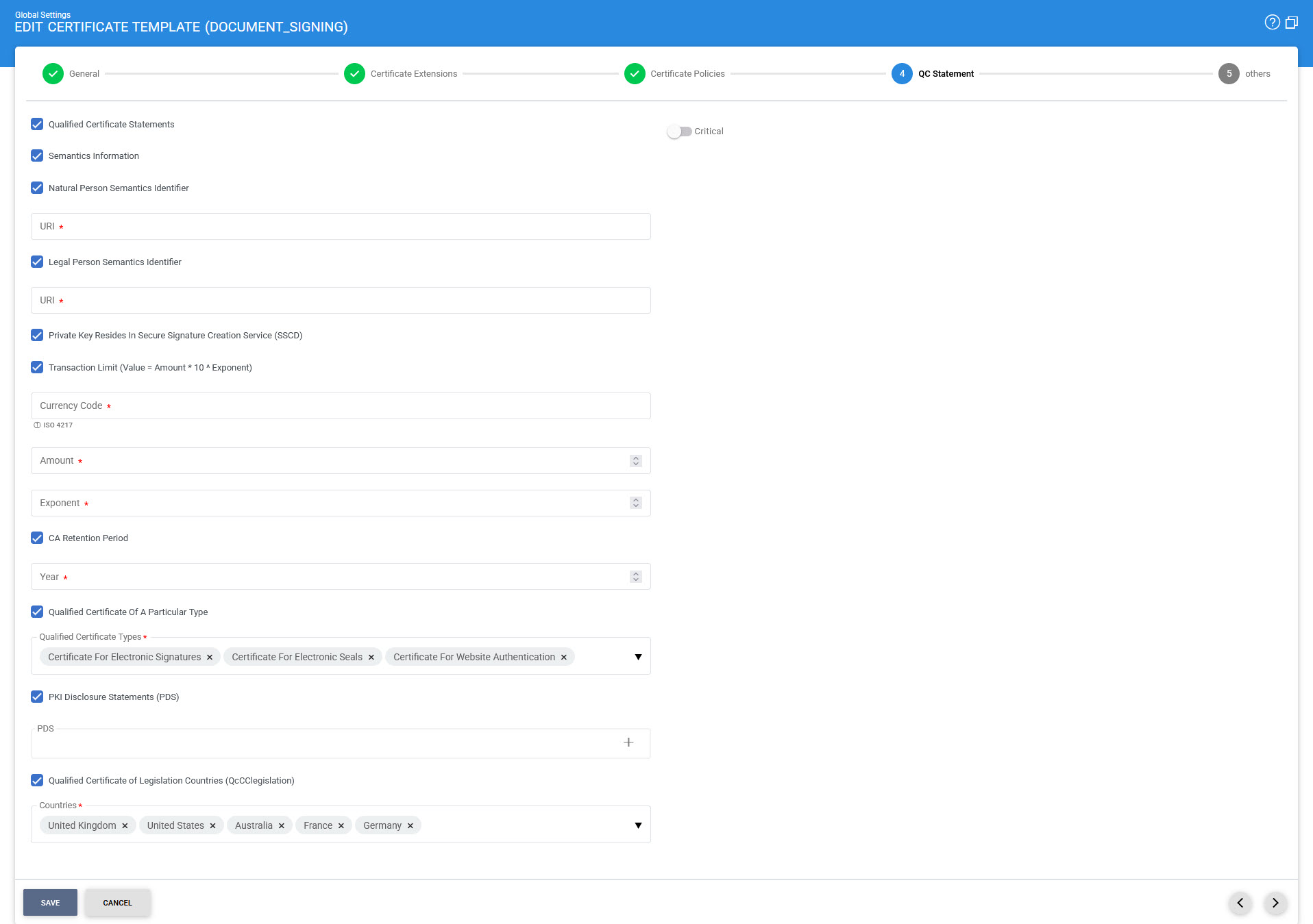
Here the user can define the required qualified certificates statements for certificate template by marking the desired checkboxes. Once done, click on the arrow button (>), it will lead you to others screen:
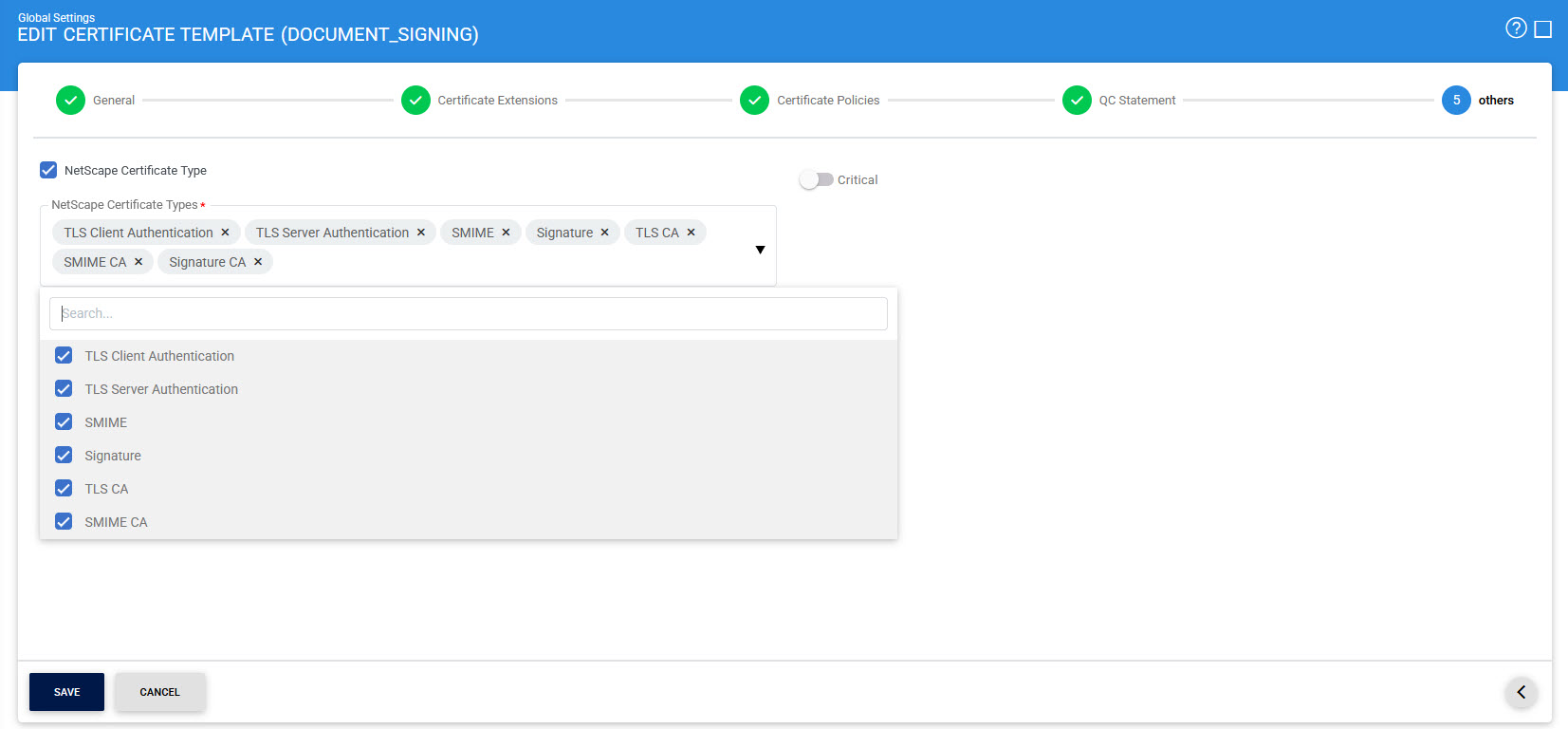
Here, the user can define the the NetScape Certificate Types from the drop-down field. Once done, click on the Save button in order to save the changes for new certificate template.
The following is a description of the above certificate template attributes. Note that some of these attributes can be specified as overridable in the Certificate Profile - see ADSS Certification Service for details:
|
Items |
Description |
||
|
General |
In General tab, the user can define the basic information about the certificate template. The configuration items for General tab are explained below: |
||
|
ID |
An user-defined unique Template ID for easier human recognition within the ADSS user Console. Once a Template ID is created, it cannot be changed. |
||
|
Name |
An user-defined unique name for easier human recognition within the ADSS user Console. |
||
|
Description |
This can be used to describe the Template in more detail. This is for information purposes only. |
||
|
Certificate Purpose |
It contains a list of standard certificate purposes. Select a purpose for which the certificate will be generated using this template. |
||
|
Certificate Type |
This drop-down menu is accessible only when the CA/B Forum and WebTrust settings are enabled, and the template is created for certificate purposes such as Email Signing (S/MIME), TLS Server or EV TLS Server. It allows the user to select the appropriate certificate type to be generated for the required key, ensuring compliance with CA/B Forum and WebTrust guidelines. S/MIME: When a certificate is generated for Email Signing (S/MIME) purposes, the user can choose from the following certificate types:
TLS Server: When a certificate is generated for TLS Server purpose, the user can choose from the following certificate types:
EV TLS Server: When a certificate is generated for EV TLS Server purpose, the user can only select the following certificate type:
|
||
|
Certificate Generation |
This drop-down menu is accessible only when the CA/B Forum and WebTrust settings are enabled, and the template is created for Email Signing (S/MIME) certificate purpose. It allows the user to select the appropriate certificate generation type, ensuring compliance with CA/B Forum and WebTrust guidelines. The list of supported Certificate Generation items are:
|
||
|
Validity Period (Months) |
It contains the time period that for how long a certificate will be valid from its creation date.
|
||
|
Hash Algorithm |
This list contains a list of supported Hash Algorithms; select one of the hash algorithm for this certificate template. The available options are SHA1, SHA224, SHA256, SHA384, SHA512, SHA3-224, SHA3-256, SHA3-384 and SHA3-512. |
||
|
Lint Certificate after Generating |
When this checkbox is enabled, the External Script Linters drop-down becomes accessible, allowing the user to select the configured linting tool. Choosing a linting tool ensures pre-issuance validation, which confirms that the certificates adhere to quality standards and comply with CA/B Forum and RFC 5280 guidelines. |
||
|
Certificate Extensions |
Certificate extension tab permits any number of additional fields to be added to the certificate. Certificate extensions provide a way of adding information such as alternative subject names and usage restrictions to certificates. The configuration items for Certificate Extensions tab are explained below: |
||
|
Key Usages |
Key usage extensions define the purpose of the public key contained in a certificate. It can be used to restrict the public key to as few or as many operations as needed.
|
||
|
Extended Key Usages |
Extended Key Usage (EKU) further refines key usage extensions. An extended key usage extension is either critical or non-critical. Critical implies that a certificate using system MUST understand and be able to process the particular attribute. Note: The relevant EKU bit must be ON otherwise the certificate will be rejected. e.g If you are using the certificate for Timestamping then the Timestamping bit must be ON otherwise timestamps created with a certificate that have no Timestamping EKU in it, will be rejected. |
||
|
Custom Extended Key Usages |
Custom Extended Key Usages (EKUs) can be added to certificates generated by the ADSS Server. In the Certificate Template, one or more Custom EKUs can be configured. Users can add their respective extension OIDs by clicking the '+' button under Custom EKUs. Extension OID: The OID of extension will be provided in 'Extension OID' field and can be added in List of Extensions by clicking the Add button. |
||
|
NoCheck |
This extension is specific to OCSP response signing certificates. IF set to TRUE then OCSP certificate revocation will not be checked by the OCSP client applications. |
||
|
Basic Constraints Type |
It contains three attributes i.e. CA, End Entity & Empty.
|
||
|
Authority Key Identifier (AKI) |
Authority Key Identifier (AKI) extension adds the hash of the issuer's public key in the target certificate. |
||
|
Subject Key Identifier (SKI) |
Subject Key Identifier (SKI) extension adds the hash of the issued public key in the target certificate. |
||
|
CRL Distribution Point (CDP) |
A CRL (Certificate Revocation List) Distribution Point identifies where CRLs for the certificate can be downloaded. CDP addresses can be configured in the module Manage CA(s). |
||
|
Authority Information Access (AIA) |
Authority Information Access (AIA) is a certificate extension that contains information useful for verifying the trust status of a certificate. This information potentially includes Uniform Resource Locators (URLs) where the issuing CA’s certificate can be retrieved, as well as a location of an Online Certificate Status Protocol (OCSP) responder configured to provide status for the certificate in question. The AIA extension can potentially contain HTTP, LDAP, or file URLs. The AIA address can be configured in the module Manage CA(s). |
||
|
Issuer Alternative Name |
If the issuing CA has the Subject Alternative Name (SAN) extension, then those SAN will be added as Issuer Alternative Name in the CRL which are enabled in its certificate template. |
||
|
Subject Alternative Name |
The subject alternative name extension allows identities to be bound to the subject of the certificate. These identities may be included in addition to or in place of the identity in the subject field of the certificate. Defined options include an internet electronic mail address, and DNS name. Other options exist, including completely local definitions. Multiple name forms, and multiple instances of each name form, may be included.
dNSName:
iPAddress:
otherName:
directoryName:
uniformResourceIdentifier: registeredID: ediPartyName: |
||
|
Name Constraints |
The Name constraint option will only be visible if 'CA' attribute is selected in 'Basic Constraint' drop down. The Name Constraint extension is used in CA certificates which specifies those constraints which will apply on Subject DN and Subject Alternative Names of subsequent certificates in CA path. These Constraints can be applied in the form of Permitted and Excluded name list ,where at least one list i.e. permitted or excluded must be present in the extension.
If a constraint is stated in permitted names list, the subsequent certificates should comply with this list and must contain only those names in their Subject DN and Subject Alternative Name (SAN) which are permitted. Following options are available in Permitted Name List.
Excluded Names: If a constraint is stated in excluded names list, then the subsequent certificates must not have those names in their Subject DN and Subject Alternative Name (SAN). Following options are available in Excluded Name List.
|
||
|
Private Key Usage Period |
This field indicates the period of the use of private key corresponding to the certified public key. The user can select the time period (i.e. days, months, years) from the drop-down and enter the required number in the field. |
||
|
Name Change |
This extension is used in a CSCA and its link certificates used in an E-Passport infrastructure. It is only visible if you have the E-Passport license and if CSCA Certificate is selected in Certificate Purpose drop-down field. By enabling this extension, the user can change Distinguished Name (DN) while rekey of a CSCA certificate.
|
||
|
Document Type |
This extension is added to Document Signer (DS) certificates in an E-Passport infrastructure. It is visible only if you have the E-Passport license and if DS Certificate is selected in Certificate Purpose drop-down field. It is a mandatory field for a DS Certificate and user can enter the document type in this field e.g. "P" for passport. |
||
|
Custom Extensions |
Custom Extensions can be added in the certificates generated by the ADSS Server. In Certificate Template one or more custom extensions can be configured. At the time of certificate generation, if the CSR contains any custom extensions, then it must match with the OID's configured in certification template. If they match the extensions will be added in the certificate, otherwise custom extensions received in CSR will be ignored. Extension OID: The OID of extension will be provided in 'Extension OID' field and can be added in List of Extensions by clicking the Add button. The extension can be marked as critical or non-critical by checking Critical checkbox. List of Extension: Extensions added in the template will be displayed in this field. Any extension can be removed from the list by clicking on the Remove button. |
||
|
Subject Directory Attribute |
The Subject Directory Attributes extension might be included and could contain extra attributes related to the subject. These attributes serve as additional information about what's already in the subject field and the subject alternative name extension. The extension is designed for storing attributes that aren't included in the subject's distinguished name but could be beneficial for various purposes, like authorization. The extension is capable of understanding the below mentioned attributes:
|
||
|
Short-Lived Certificate |
Short-lived certificates are certificates with a limited lifespan i.e. they remain active only until a document signing occurs.Once signed, both the user and their associated keys are deleted. It is a license based feature and will only be available to the user if Unity Service is enabled in the license. If the extension is enabled, it will automatically include the Short-Lived Certificate Extension OID '0.4.0.194121.2.1' in the certificate. |
||
|
Certificate Policies |
The Certificate Policies extension defines one or more policies, each of which consists of an OID and optional qualifiers. The extension can include a URI to the issuer's Certificate Practice Statement or can embed issuer information, such as a user notice in text form. The Certificate Policy provides the information that can be used by a certificate user to decide whether or not to trust a certificate. Certificate policies are also used to establish trust relationships between CAs (i.e. cross certification). When CAs issue cross certificates, one CA assesses and recognizes one or more certificate polices of the other CA.
|
||
|
Qualified Certificate Statements |
Defines unambiguous identification of the EU Qualified Certificate type of the end user for QES (Qualified Electronic Signatures) creation by means of OID in QCStatements in accordance with IETF RFC 3739 and especially with ETSI EN 319 412-1. This allows the configuration of various aspects of the ETSI Qualified Certificate profile statements, i.e. this is a qualified certificate, Semantics Information, PKI Disclosure Statements, transaction value limit, CA retention period and whether the private key held on a Secure Signature Creation Device (SSCD), typically an evaluated smart card that has achieved a particular security assurance level. Defines an identifier about the semantics of data stored in the certificate i.e. whether the certificate is issued to a natural person or legal person:
When enabled, ADSS CA Server automatically adds the semantic identifier based on the selected configuration i.e. Natural or Legal Person Private key resides in Secure Signature Creation Service (SSCD): Defines an Identifier (represented by an OID), made by the CA, stating that the private key associated with the public key in the certificate is stored in a Secure Signature Creation Device according to Annex III of the EU Directive 1999/93/EC [1], as implemented in the law of the country where the CA is established. The private key cannot be exported from the secure device and is under a sole control of a person to whom the qualified certificate was issued. This impose a limitation on the value of transaction for which this certificate can be used to the specified amount (Monetary Value). Alphabetic or numeric currency code can be used as defined in ISO 4217. Defines a retention period in years for material information relevant to the use of and reliance on the certificate, that will be archived and can be made available upon request beyond the end of the validity period of the certificate. Qualified Certificate of a particular type: Defines the type of qualified certificate i.e.
This type is used in combination with the Semantic Identifier selected above i.e. Certificate for Electronic Signature used by Natural Person. Defines the URL for the PDS document (a supplemental instrument of disclosure and notice by CA) and language code for this PDF document as defined in ISO 639-1. PDS document is intended to provide PKI participants (subscribers and relying parties) with a short extract of Qualified Certificates for Electronic Seals PKI policy documentation which focuses on key information of interest to users. It assists CA to respond to regulatory requirements and concerns, particularly those related to consumer deployment. Multiple PDS URLs and language codes can be added by using the + button.
|
||
|
NetScape Certificate Type |
Netscape has defined certain certificate extensions for its products. Some of the extensions are now obsolete, and others have been superseded by the extensions defined in the X.509 standard. |
Note that the ADSS local CA and Key Manager will use the relevant certificate template when certifying a particular public key. These modules will determine which template to use by identifying the purpose of the key pair and then using the relevant certificate template for that key purpose.
|
|
Copy of a Certificate Template is created without the Name and Description and ID of a selected Certificate Template. |
|
|
For S/MIME certificates:
|
|
|
Refer to RFC 5280, Internet X.509 Public Key Infrastructure Certificate and Certificate Revocation List (CRL) Profile, for a further discussion on the above certificate attributes and recommendations for whether these should be marked as 'critical' or 'non-critical'. Critical implies that a certificate using system MUST understand and be able to process the particular attribute. |
See also
System Certificates
Certificate Purposes
Certificate Templates
CV Certificate Templates
PDF Signature Appearances
PDF Signature Locations
External Script Linters
System Alerts
High Availability
System Security

